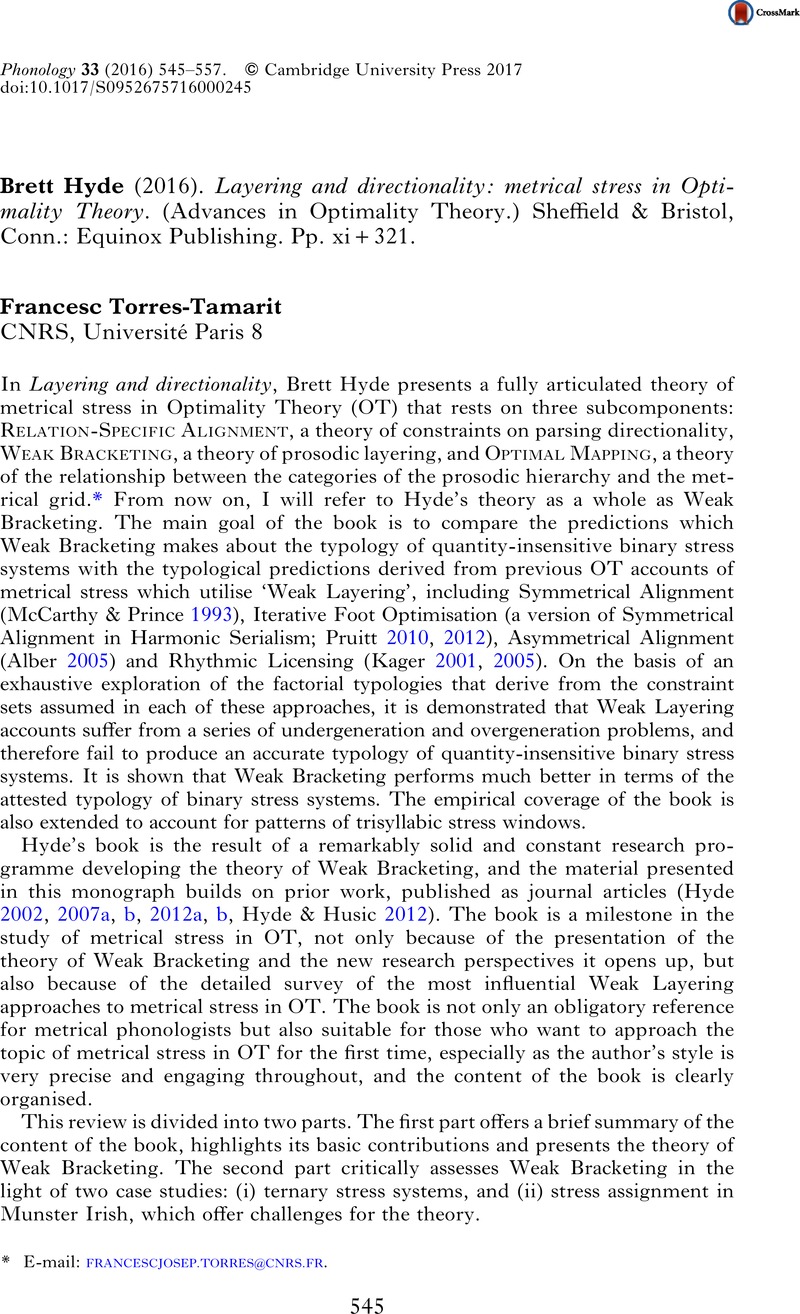No CrossRef data available.
Article contents
Brett Hyde (2016). Layering and directionality: metrical stress in Optimality Theory. (Advances in Optimality Theory.) Sheffield & Bristol, Conn.: Equinox Publishing. Pp. xi+321.
Review products
Brett Hyde (2016). Layering and directionality: metrical stress in Optimality Theory. (Advances in Optimality Theory.) Sheffield & Bristol, Conn.: Equinox Publishing. Pp. xi+321.
Published online by Cambridge University Press: 16 January 2017
Abstract
An abstract is not available for this content so a preview has been provided. Please use the Get access link above for information on how to access this content.

- Type
- Reviews
- Information
- Copyright
- Copyright © Cambridge University Press 2017
References
REFERENCES
Elenbaas, Nine & Kager, René (1999). Ternary rhythm and the lapse constraint. Phonology
16. 273–329.Google Scholar
Hayes, Bruce (1995). Metrical stress theory: principles and case studies. Chicago: University of Chicago Press.Google Scholar
Hermans, Ben & Torres-Tamarit, Francesc (2014). Ternary constituents are a consequence of mora sluicing. In Kingston, John, Moore-Cantwell, Claire, Pater, Joe & Staubs, Robert (eds.) Proceedings of the 2013 Meeting on Phonology. Available (August 2016) at http://journals.linguisticsociety.org/proceedings/index.php/amphonology/article/view/26.Google Scholar
Hyde, Brett (2007a). Issues in Banawá prosody: onset sensitivity, minimal words, and syllable integrity. LI
38. 239–285.Google Scholar
Hyde, Brett (2007b). Non-finality and weight-sensitivity. Phonology
24. 287–334.CrossRefGoogle Scholar
Hyde, Brett & Husic, Brooke (2012). Ancient Greek accent windows. Revista Letras e Letras
28. 29–58.Google Scholar
Iosad, Pavel (2013). Head-dependent asymmetries in Munster Irish prosody. Nordlyd
40. 66–107.Google Scholar
Kager, René (2001). Rhythmic directionality by positional licensing. Handout of paper presented at the 5th Holland Institute of Linguistics Phonology Conference, Potsdam. Available as ROA-514 from the Rutgers Optimality Archive.Google Scholar
Kager, René (2005). Rhythmic licensing theory: an extended typology. Proceedings of the 3rd Seoul International Conference on Linguistics (SICOL). Seoul: Linguistic Society of Korea. 5–31.Google Scholar
McCarthy, John J. & Prince, Alan (1993). Generalized alignment. Yearbook of Morphology
1993. 79–153.CrossRefGoogle Scholar
Martínez-Paricio, Violeta (2013). An exploration of minimal and maximal feet. PhD dissertation, University of Tromsø.Google Scholar
Martínez-Paricio, Violeta & Kager, René (2015). The binary-to-ternary continuum in stress typology: layered feet and non-intervention constraints. Phonology
32. 459–504.Google Scholar
Pruitt, Kathryn (2010). Serialism and locality in constraint-based metrical parsing. Phonology
27. 481–526.Google Scholar
Pruitt, Kathryn (2012). Stress in Harmonic Serialism. PhD dissertation, University of Massachusetts Amherst.Google Scholar
Torres-Tamarit, Francesc & Hermans, Ben (forthcoming). Branchingness constraints on heads and dependents in Munster Irish stress. Glossa.Google Scholar
Ulfsbjorninn, Shanti (2014). A field theory of stress: the role of empty nuclei in stress systems. PhD dissertation, University of London.Google Scholar




